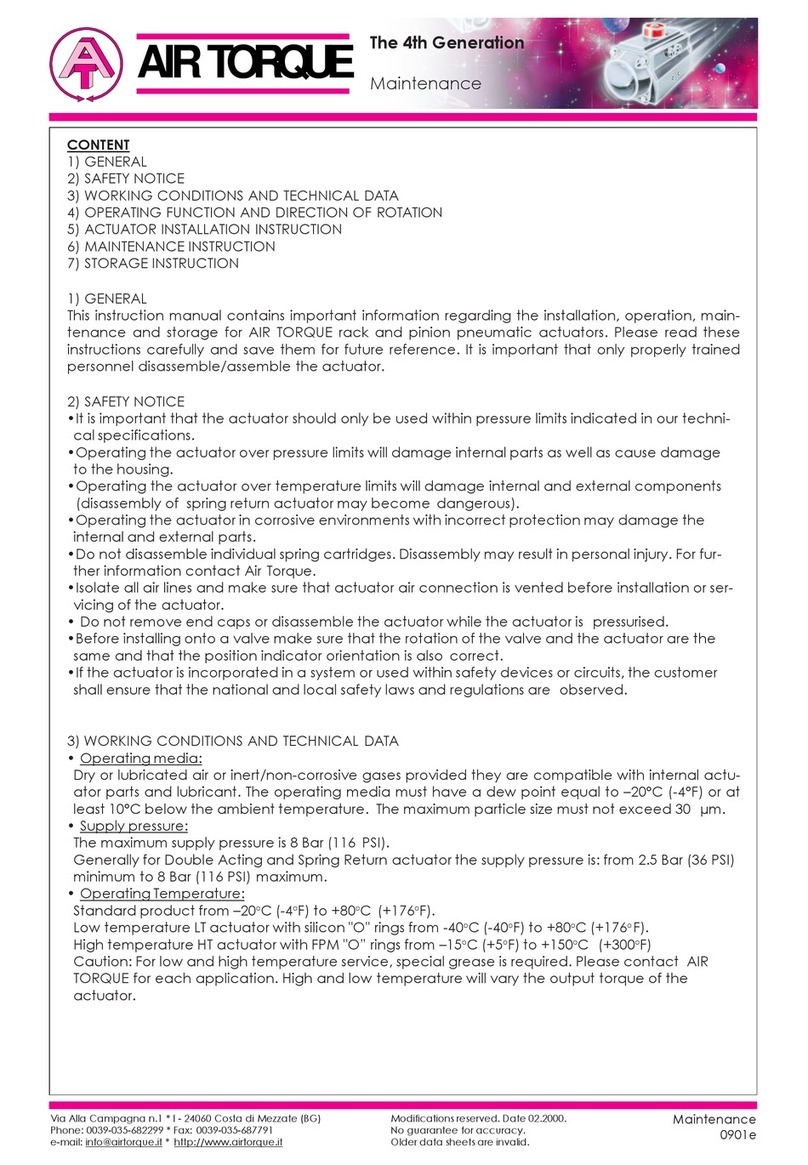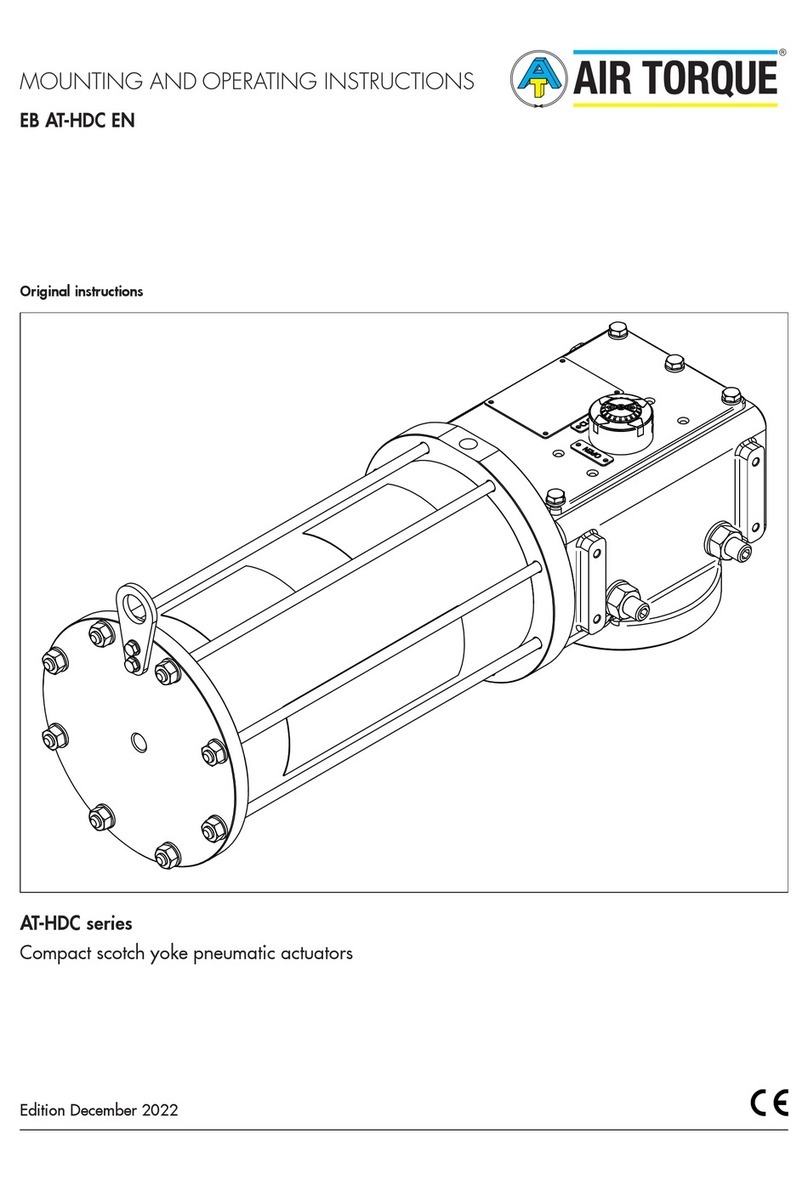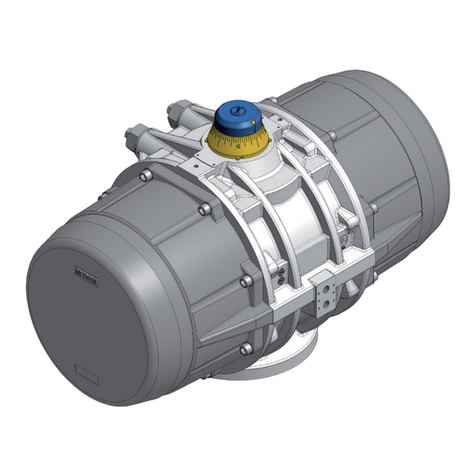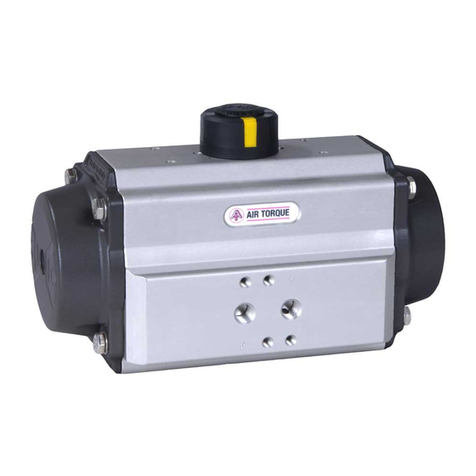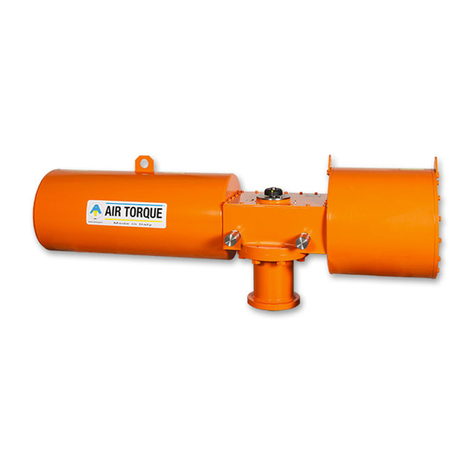EB AT-RP-4GU EN 1-1
Safety instructions and measures
1 Safety instructions and measures
Intended use
The AIR TORQUE 4th Generation Upgrade Series actuators
are designed for the automation and operation of quarter-
turn valves such as butterfly valves, ball valves and plug
valves in both indoor and outdoor applications. Depending
on the configuration, the actuator is suitable for on/off or
modulating duties. The actuator can be used in process and
industrial plants.
The actuator is designed to operate under exactly defined
conditions (e.g. temperature, pressure, travel). Therefore,
operators must ensure that the actuator is only used in
operating conditions that meet the specifications used for
sizing the actuator at the ordering stage. In case operators
intend to use the actuator in other applications or conditions
than specified, contact AIR TORQUE.
AIR TORQUE does not assume any liability for damage
resulting from the failure to use the device for its intended
purpose or for damage caused by external forces or any
other external factors.
ÎRefer to the technical data and nameplate for limits and
fields of application as well as possible uses.
Reasonably foreseeable misuse
The actuator is not suitable for the following applications:
−Use outside the limits defined during sizing and by the
technical data.
−Use outside the limits defined by the accessories connected
to the actuator.
Furthermore, the following activities do not comply with the
intended use:
−Use of non-original spare parts.
−Performing service and repair work not described in these
instructions.
Qualifications of operating personnel
The actuator must be mounted, started up, serviced and re-
paired by fully trained and qualified personnel only; the ac-
cepted industry codes and practices are to be observed. Ac-
cording to these mounting and operating instructions, trained
personnel refers to individuals who are able to judge the work
they are assigned to and recognize possible hazards due to
their specialized training, their knowledge and experience as
well as their knowledge of the applicable standards.
Personal protective equipment
We recommend wearing the following personal protective
equipment when handling the AIR TORQUE actuators:
−Protective gloves and safety footwear when mounting or
removing the actuator.
−Eye protection and hearing protection while the actuator is
operating.
ÎCheck with the plant operator for details on further protec-
tive equipment.
Revisions and other modifications
Revisions, conversions or other modifications of the product
are not authorized by AIR TORQUE. They are performed at
the user‘s own risk and may lead to safety hazards, for ex-
ample. Furthermore, the product may no longer meet the re-
quirements for its intended use.
Safety devices
The AIR TORQUE pneumatic actuators alone do not have any
special safety equipment.
Warning against residual hazards
To avoid personal injury or property damage, plant operators
and operating personnel must prevent hazards that could be
caused in the actuator by the signal pressure, stored spring
energy or moving parts by taking appropriate precautions.
They must observe all hazard statements, warning and cauti-
on notes in these mounting and operating instructions.
Responsibilities of the operator
The operator is responsible for proper operation and compli-
ance with the safety regulations. Operators are obliged to
provide these mounting and operating instructions as well as
the referenced documents to the operating personnel and to
instruct them in proper operation.
Furthermore, the operator must ensure that operating person-
nel or third persons are not exposed to any danger.
These instructions should not supersede or replace any custo-
mer’s plant safety or work procedures. If a conflict arises bet-
ween these instructions and the customer’s procedures, the dif-
ferences should be resolved in writing between an authorized
end user‘s representative and an authorized AIR TORQUE re-
presentative.
Responsibilities of operating personnel
Operating personnel must read and understand these moun-
ting and operating instructions as well as the referenced docu-
ments and observe the specified hazard statements, warnings
and caution notes. Furthermore, the operating personnel must
be familiar with the applicable health, safety and accident
prevention regulations and comply with them.
Referenced standards and regulations
−AIR TORQUE actuators are designed, produced and clas-
sified according to the European Atex directive 2014/34/
EU. Before using the actuators in potentially explosive at-
mosphere areas, verify the actuator compliance with the
required ATEX classification.
ÎRefer to the nameplate and the ATEX safety instructions.
−4th Generation Upgrade Series actuators are SIL certifica-
ted.
ÎRefer to the SIL Certificate available from AIR TORQUE for
the 4th Generation Upgrade Series actuators SIL capabili-
ty.
−Referring to Machine Directive 2006/42/EC, actuators
are classified as “partly machinery” (see Declaration of
incorporation).
Therefore, the actuator cannot to be put into service until

